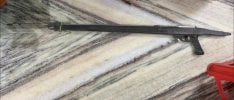Hello Guys,
This is my first post on this forum.
I recently acquired a speargun from ScubaPro that I believe is more than 30 or 40 years old. I think the name of the speargun is ScubaPro Panther.
The same exact speargun is still sold by this brand called Bandito.
1) The speargun I purchased has a few things missing on it. The rubber power bands, slide ring and the rubber butt loading pad. I would like to know if the later two missing components are availiable as spare parts to be purchased online and will it be delivered internationally? If not, what can I use as an alternative?
2) Furthermore, where can I find the official specs of this speargun? I would like to know what is the min - max shaft thickness this speargun can handle. To add to that, I am also trying to find out what is the maximum rubber power band thickness and configuration it can handle.
3) I have noticed that this speargun does not have an eyehole or a provision to attach it to my buoy. This means I will have to drill a hole on it's body and tie a dyneema cord around it to which I can then tie my buoy. I would like to know where would be the ideal spot to drill this hole without compromising the structural integrity.
4) Can this speargun use a sharkfin shaft without getting stuck or damaging the muzzle on it way out after shooting? If using a sharkfin shaft, will I be able to add it to a break away rig? This is my first open muzzle speargun.
Thanks you for all the help in advance. I am attaching an image of the speargun for reference.
This is my first post on this forum.
I recently acquired a speargun from ScubaPro that I believe is more than 30 or 40 years old. I think the name of the speargun is ScubaPro Panther.
The same exact speargun is still sold by this brand called Bandito.
1) The speargun I purchased has a few things missing on it. The rubber power bands, slide ring and the rubber butt loading pad. I would like to know if the later two missing components are availiable as spare parts to be purchased online and will it be delivered internationally? If not, what can I use as an alternative?
2) Furthermore, where can I find the official specs of this speargun? I would like to know what is the min - max shaft thickness this speargun can handle. To add to that, I am also trying to find out what is the maximum rubber power band thickness and configuration it can handle.
3) I have noticed that this speargun does not have an eyehole or a provision to attach it to my buoy. This means I will have to drill a hole on it's body and tie a dyneema cord around it to which I can then tie my buoy. I would like to know where would be the ideal spot to drill this hole without compromising the structural integrity.
4) Can this speargun use a sharkfin shaft without getting stuck or damaging the muzzle on it way out after shooting? If using a sharkfin shaft, will I be able to add it to a break away rig? This is my first open muzzle speargun.
Thanks you for all the help in advance. I am attaching an image of the speargun for reference.



